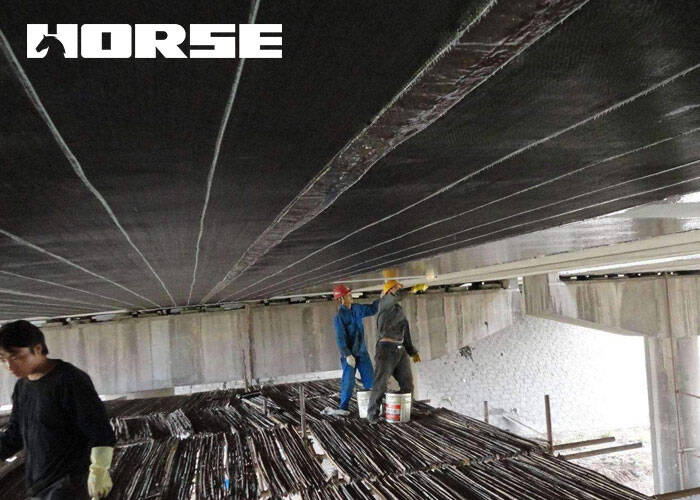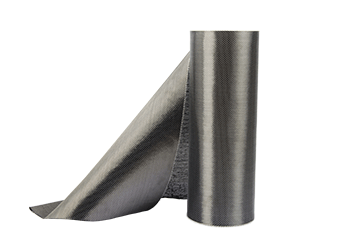Solutions
Horse Construction offers full range of structural strengthening materials with technical supports, documentation supports, products supports, project supports.
Carbon fiber reinforcement

Introduction to Carbon Fiber Reinforcement Methods in Bridge Reinforcement Engineering
Analysis of the mechanical characteristics of carbon fiber reinforced bridges
(1) Compared with other traditional reinforcement methods, the use of carbon fiber cloth to reinforce the old bridge can minimize the stress distribution of the original structure and ensure that it is under the same force with the original structure within the design load range.
(2) Stick a carbon fiber cloth with excellent tensile strength to the bottom surface of the beam with a bonding material to make it participate in the force with the original structure. That is, the carbon fiber cloth can bear the tensile force together with the steel bars arranged in the original structure to improve the bearing capacity of the old bridge.
(3) Paste the carbon fiber cloth along the direction of the main tensile stress or the direction orthogonal to the cracks, with fixed ends on both sides, which can restrain the concrete surface cracks and prevent the development of cracks. So as to achieve the purpose of improving the bending rigidity of the component, reducing the deflection of the component, and improving the stress state of the beam body.
(4) Carbon fiber cloth reinforced concrete members can not only improve the flexural load-bearing capacity, but also may affect the failure mode of the flexural members. When the amount of carbon fiber cloth is too much, the ductility of the component will decrease.
Technical characteristics of carbon fiber cloth reinforcement of bridge
(1) High strength and high efficiency. Due to the excellent physical and mechanical properties of carbon fiber cloth, its high strength and high elastic modulus characteristics can be fully utilized in the reinforcement and repair of concrete structures to improve the bearing capacity and tensile performance of the structure.
(2) The construction is convenient, the work efficiency is high, large construction tools are not needed, and the construction takes up less space. The finished carbon fiber cloth is a kind of fabric, which can be cut arbitrarily with scissors or blades when used on site, without the need for special cutting tools.
(3) The structural form and appearance are not changed, and the weight of the original structure and the size of the original components are basically not increased. The weight of the paste is less than 1.0kg per square meter.
(4) The construction quality is the easiest to guarantee. Since the pasted carbon fiber cloth is flexible, even if the surface of the reinforced structure is not very flat, it can basically achieve an effective bonding rate of 100%.
Introduction To Other Carbon Fiber Reinforcement Technologies
NSMR reinforcement technology
Near-Surface-Mounted Reinforcement (NSMR) is a new carbon fiber reinforcement technology developed in recent years. NSMR is to use epoxy resin embedded carbon fiber slats in the concrete protective layer to strengthen the concrete members. The construction process of the NSMR method is to cut the concrete protective layer into the groove along the longitudinal direction of the beam, then inject the epoxy resin into the groove, then insert the carbon fiber slats into the groove, and finally pour resin to fill the groove.
The advantages of NSMR reinforcement technology over the external carbon fiber cloth reinforcement technology are:
The bond with the concrete has been strengthened, making the force transmission of the carbon fiber slats more effective.
It can be adapted to the irregular surface of concrete members.
Carbon fiber slats can be effectively protected and improved durability.
MF-FRP method
A reinforcement method MF-FRP (Mechanically-Fastened MF-FRP) for mechanically anchoring fiber composite strips. The difference between the MF-FRP method and the external reinforcement technology is that it uses the fiber composite material strip and the concrete beam to work together through mechanical tracing.
The advantages of the MF-FRP method over the external reinforcement technology are:
The MF-FRP method does not require treatment of the concrete surface, making the reinforcement procedure easier.
The MF-FRP method does not affect the use of reinforced components. The external bonding reinforcement technology requires at least 24 hours to dry the epoxy resin paste, and it can be put into use after one week of reinforcement.
The MF-FRP method does not need to paste the U-shaped pin.
Use materials and precautions. The reinforcement material used in the MF-FRP method is slats mixed with carbon fiber and glass fiber, usually with a width of 102mm and a thickness of 3.2mm. The uranium solid material used in the reinforcement is a tack or expansion bolt, and the machine that drives the solid material is an air gun. Before using the slats, pre-drill shallow holes with the same diameter as the fixed material at intervals in the concrete base. At the same time, the corresponding position of the slat should be drilled to prevent the concrete from peeling and scattering when the air gun is driven into the tracing material.
Construction sequence. The construction sequence of the MF-FRP method is as follows: Drill a shallow hole with a depth of 12mm in the concrete base layer, and drill holes in the corresponding position of the carbon fiber slats. The carbon fiber slats are cut to the required length. Use an air gun to trace and fix the carbon fiber slats. The resin fills the gap between the carbon fiber slats and the concrete base layer.
Conclusion
To reinforce the concrete structure with carbon fiber cloth, the construction process should be strictly followed. The concrete surface should be relatively flat, dry and dust-free. The carbon fiber cloth should be fully infiltrated when pasting. The construction quality must be strictly controlled during the construction process, otherwise it will affect the reinforcement effect.
You can find anything here you are in need of, have a trust trying on these products, you will find the big difference after that.

High strength carbon fiber reinforced polymer (CFRP) strip / laminate / plate for structural strengthening and concrete repair

High strength, unidirectional carbon fiber fabric pre-saturated to form a carbon fiber reinforced polymer (CFRP) fabric used to strengthen structural concrete elements.

High strength, unidirectional carbon fiber sheet pre-saturated to form a carbon fiber reinforced polymer (CFRP) sheet used to strengthen structural concrete elements.